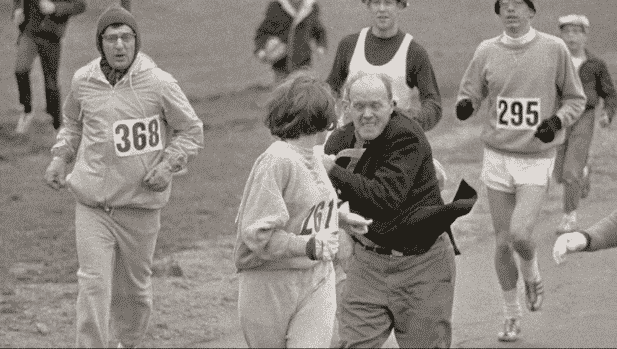

Kathrine retold the story of her groundbreaking run in an ApNY Times article “From K.V. She was the first to run with a race number 261. She would run a world class time of 2:51:37 eight years later for a second place finish at the 1975 Boston Marathon, on this day her time was 4:20.

Kathrine Switzer becomes the second female to run the Boston Marathon. Miller died of a heart attack in 1992.Celebrating the Early Women Pioneers of Long Distance Running Miller was removed by the Amateur Athletic Union for his bodycheck of Semple and married Switzer in 1968. He said he didn’t need to train because “if a girl can run a marathon, I can run a marathon”. Tom MillerĪ 235lb American football player and national-ranked hammer thrower, Miller announced he was going to join his then girlfriend and run Boston. When she completed the 2017 Boston, 50 years after her initial run, the race organisers retired her 261 number. “I was just a 20-year-old kid who wanted to run.” Switzer began to advocate for women’s rights and played a pivotal role in the successful campaign to get the women’s marathon into the 1984 Olympics. Kathrine Switzerīorn in Germany to an American army family, the athletic and head-strong Switzer said she had no intention of making history when she became the first woman to run the Boston Marathon in 1967 as a numbered entrant. No longer were woman deemed too fragile to complete 26.2 miles.įive years later women were finally allowed to run the Boston Marathon officially. Her then boyfriend, Tom Miller, manhandled Semple and the flashpoint became a symbol in running of female empowerment. Four miles into the race, Switzer was attacked by race director Jock Semple. The rules did not prevent women from running, but they could only join from the sidelines and run without a number. Switzer’s application slipped through the net as she signed the entry form using her initials KV Switzer. Little did Kathrine Switzer know, when she pinned bib No 261 to her sweatshirt and lined up for the Boston Marathon in 1967, her appearance would make front pages of newspapers around the world.īack then, women were not allowed to run more than 1,500 metres in sanctioned races. Who were the individuals captured in the historic photograph and what happened next? This month we look back on the iconic image of American runner Kathrine Switzer pushed aside by a race official at the Boston Marathon in 1967. Moment In Time will become a regular feature on our TWS channels.


 0 kommentar(er)
0 kommentar(er)
